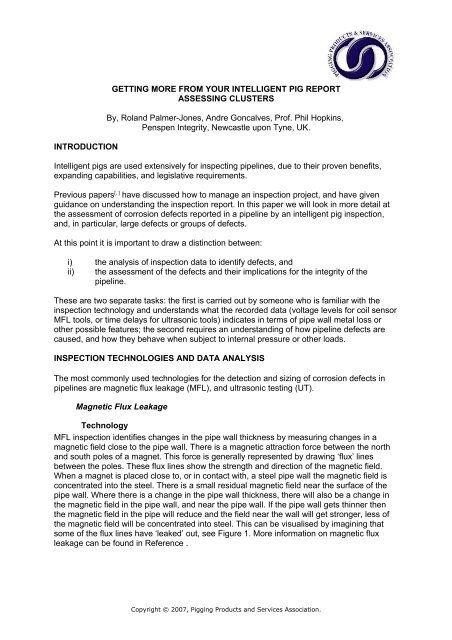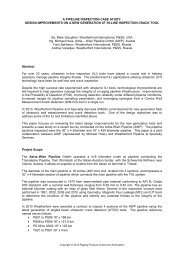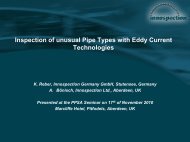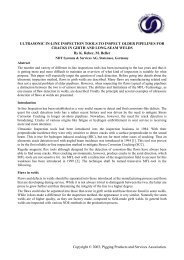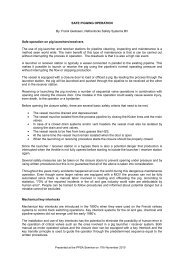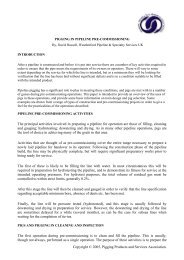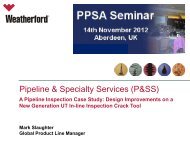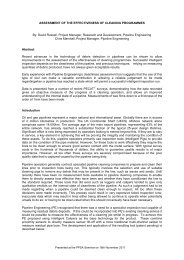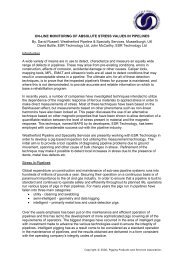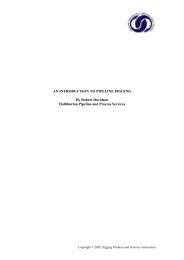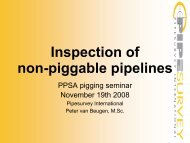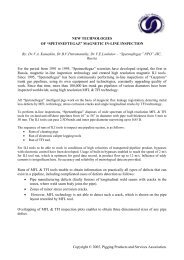Show Paper - PPSA, the Pigging Products and Services Association ...
Show Paper - PPSA, the Pigging Products and Services Association ...
Show Paper - PPSA, the Pigging Products and Services Association ...
You also want an ePaper? Increase the reach of your titles
YUMPU automatically turns print PDFs into web optimized ePapers that Google loves.
INTRODUCTION<br />
GETTING MORE FROM YOUR INTELLIGENT PIG REPORT<br />
ASSESSING CLUSTERS<br />
By, Rol<strong>and</strong> Palmer-Jones, Andre Goncalves, Prof. Phil Hopkins,<br />
Penspen Integrity, Newcastle upon Tyne, UK.<br />
Intelligent pigs are used extensively for inspecting pipelines, due to <strong>the</strong>ir proven benefits,<br />
exp<strong>and</strong>ing capabilities, <strong>and</strong> legislative requirements.<br />
Previous papers [, ] have discussed how to manage an inspection project, <strong>and</strong> have given<br />
guidance on underst<strong>and</strong>ing <strong>the</strong> inspection report. In this paper we will look in more detail at<br />
<strong>the</strong> assessment of corrosion defects reported in a pipeline by an intelligent pig inspection,<br />
<strong>and</strong>, in particular, large defects or groups of defects.<br />
At this point it is important to draw a distinction between:<br />
i) <strong>the</strong> analysis of inspection data to identify defects, <strong>and</strong><br />
ii) <strong>the</strong> assessment of <strong>the</strong> defects <strong>and</strong> <strong>the</strong>ir implications for <strong>the</strong> integrity of <strong>the</strong><br />
pipeline.<br />
These are two separate tasks: <strong>the</strong> first is carried out by someone who is familiar with <strong>the</strong><br />
inspection technology <strong>and</strong> underst<strong>and</strong>s what <strong>the</strong> recorded data (voltage levels for coil sensor<br />
MFL tools, or time delays for ultrasonic tools) indicates in terms of pipe wall metal loss or<br />
o<strong>the</strong>r possible features; <strong>the</strong> second requires an underst<strong>and</strong>ing of how pipeline defects are<br />
caused, <strong>and</strong> how <strong>the</strong>y behave when subject to internal pressure or o<strong>the</strong>r loads.<br />
INSPECTION TECHNOLOGIES AND DATA ANALYSIS<br />
The most commonly used technologies for <strong>the</strong> detection <strong>and</strong> sizing of corrosion defects in<br />
pipelines are magnetic flux leakage (MFL), <strong>and</strong> ultrasonic testing (UT).<br />
Magnetic Flux Leakage<br />
Technology<br />
MFL inspection identifies changes in <strong>the</strong> pipe wall thickness by measuring changes in a<br />
magnetic field close to <strong>the</strong> pipe wall. There is a magnetic attraction force between <strong>the</strong> north<br />
<strong>and</strong> south poles of a magnet. This force is generally represented by drawing ‘flux’ lines<br />
between <strong>the</strong> poles. These flux lines show <strong>the</strong> strength <strong>and</strong> direction of <strong>the</strong> magnetic field.<br />
When a magnet is placed close to, or in contact with, a steel pipe wall <strong>the</strong> magnetic field is<br />
concentrated into <strong>the</strong> steel. There is a small residual magnetic field near <strong>the</strong> surface of <strong>the</strong><br />
pipe wall. Where <strong>the</strong>re is a change in <strong>the</strong> pipe wall thickness, <strong>the</strong>re will also be a change in<br />
<strong>the</strong> magnetic field in <strong>the</strong> pipe wall, <strong>and</strong> near <strong>the</strong> pipe wall. If <strong>the</strong> pipe wall gets thinner <strong>the</strong>n<br />
<strong>the</strong> magnetic field in <strong>the</strong> pipe will reduce <strong>and</strong> <strong>the</strong> field near <strong>the</strong> wall will get stronger, less of<br />
<strong>the</strong> magnetic field will be concentrated into steel. This can be visualised by imagining that<br />
some of <strong>the</strong> flux lines have ‘leaked’ out, see Figure 1. More information on magnetic flux<br />
leakage can be found in Reference .<br />
Copyright © 2007, <strong>Pigging</strong> <strong>Products</strong> <strong>and</strong> <strong>Services</strong> <strong>Association</strong>.
N MAGNET S<br />
Pipe Wall<br />
Flux Lines<br />
Figure 1 Magnetic Flux Leakage.<br />
Sensors are used to measure <strong>the</strong>se changes in <strong>the</strong> magnetic field close to <strong>the</strong> pipe wall.<br />
These sensors are ei<strong>the</strong>r coil sensors or Hall effect sensors. The signals output from <strong>the</strong>se<br />
sensors are recorded, <strong>and</strong> used to estimate <strong>the</strong> depth (relative to <strong>the</strong> pipe wall thickness),<br />
length <strong>and</strong> width of <strong>the</strong> corrosion defect. It is based primarily on <strong>the</strong> proportion of <strong>the</strong><br />
magnetic field that leaks out of <strong>the</strong> pipe wall. Typical MFL inspection pigs have a large<br />
number of sensors arranged around <strong>the</strong> circumference of <strong>the</strong> pipe, see Figure 2, but it is<br />
important to remember that only a relative measurement of defect depth can be made,<br />
Figure 2 MFL Pig Sensors<br />
The signals recorded by all sensors are interpreted ei<strong>the</strong>r automatically using specially<br />
developed software or by an analyst who views <strong>the</strong> data on screen, Figure 3. Individual<br />
defects are identified (often <strong>the</strong> area of <strong>the</strong> defect is defined by a ‘box’), <strong>and</strong> <strong>the</strong> dimensions<br />
estimated. The accuracy of <strong>the</strong>se estimates will vary with <strong>the</strong> particular inspection tool, <strong>the</strong><br />
type of pipe being inspected (e.g. seam welded or seamless), <strong>the</strong> dimensions of <strong>the</strong> defects,<br />
<strong>the</strong> experience of <strong>the</strong> analyst, etc. These dimensions are reported in <strong>the</strong> defect listing.<br />
Page 2 of 13<br />
Copyright © 2007, <strong>Pigging</strong> <strong>Products</strong> <strong>and</strong> <strong>Services</strong> <strong>Association</strong>.
Corrosion Defects<br />
Figure 3 MFL Data on Screen<br />
MFL <strong>and</strong> Reporting Defects<br />
Where <strong>the</strong>re are a large number of defects close toge<strong>the</strong>r <strong>the</strong>se may be grouped or<br />
‘clustered’, <strong>and</strong> for conservatism <strong>and</strong> simplicity reported as a single defect, with a length<br />
equal to <strong>the</strong> overall length of <strong>the</strong> cluster, a width equal to <strong>the</strong> overall width of <strong>the</strong> cluster, <strong>and</strong><br />
a depth equal to <strong>the</strong> maximum defect depth. An example of how two defects may be<br />
combined is given in Figure 4. This defect grouping or ‘clustering’ will follow set rules<br />
generally based on <strong>the</strong> axial or circumferential separation of <strong>the</strong> defects. A typical clustering<br />
rule is to combine two defects if <strong>the</strong> axial separation is less than three times <strong>the</strong> pipe wall<br />
thickness [] .<br />
Page 3 of 13<br />
Copyright © 2007, <strong>Pigging</strong> <strong>Products</strong> <strong>and</strong> <strong>Services</strong> <strong>Association</strong>.
Figure 4 Defect Grouping (Clustering) Example<br />
Figure 5 shows a typical defect cluster. Individual defects are identified by blue ovals, <strong>the</strong>re<br />
are many defects close toge<strong>the</strong>r, <strong>the</strong>se have been grouped, <strong>and</strong> <strong>the</strong> group is identified by <strong>the</strong><br />
orange rectangle, which defines <strong>the</strong> defect reported in <strong>the</strong> final defect listing. Therefore, a<br />
defect that is listed in an inspection report could be a single defect, or could be cluster of<br />
numerous real defects, as shown in Figure 5.<br />
Page 4 of 13<br />
Copyright © 2007, <strong>Pigging</strong> <strong>Products</strong> <strong>and</strong> <strong>Services</strong> <strong>Association</strong>.
Cluster - Orange<br />
Individual defect - Blue<br />
Figure 5 Defect Grouping<br />
A typical defect listing is shown in Figure 6. In this case <strong>the</strong>re is no differentiation between<br />
individual defects <strong>and</strong> groups of defects that have been clustered.<br />
Page 5 of 13<br />
Copyright © 2007, <strong>Pigging</strong> <strong>Products</strong> <strong>and</strong> <strong>Services</strong> <strong>Association</strong>.
Figure 6 Typical MFL Inspection Defect Listing<br />
Ultrasonic Inspection<br />
Ultrasonic inspection is a method for measuring <strong>the</strong> pipe wall thickness based on firing a<br />
pulse of ultrasound into <strong>the</strong> pipe wall <strong>and</strong> recording <strong>the</strong> time taken for reflections to come<br />
back to <strong>the</strong> transducer. This is illustrated in Figure 7. With knowledge of <strong>the</strong> speed of sound<br />
in <strong>the</strong> coupling medium, <strong>and</strong> <strong>the</strong> pipe steel, <strong>the</strong> st<strong>and</strong> off distance <strong>and</strong> <strong>the</strong> pipe wall thickness<br />
can be estimated. Where <strong>the</strong>re is an internal defect <strong>the</strong> st<strong>and</strong>-off distance will increase,<br />
where <strong>the</strong>re is an external defect <strong>the</strong> back wall echo will return sooner. For more information<br />
on ultrasonic inspection technology see Reference .<br />
Page 6 of 13<br />
Copyright © 2007, <strong>Pigging</strong> <strong>Products</strong> <strong>and</strong> <strong>Services</strong> <strong>Association</strong>.
Timer<br />
UT Transducer<br />
St<strong>and</strong> off<br />
Back wall echo<br />
Pipe wall<br />
Figure 7 UT Measurement<br />
UT inspection tools usually have numerous sensors, generally mounted in a sensor module<br />
that is towed behind <strong>the</strong> main pig. An example of a UT tool sensor carrier is shown in Figure<br />
8.<br />
Figure 8 UT Sensor Carrier (courtesy of NDT)<br />
The data collected by an ultrasonic inspection pig is often presented as a colour plot with<br />
different colours denoting different remaining wall thickness. A typical example is shown in<br />
Figure 9.<br />
Page 7 of 13<br />
Copyright © 2007, <strong>Pigging</strong> <strong>Products</strong> <strong>and</strong> <strong>Services</strong> <strong>Association</strong>.
Figure 9 UT Inspection Data<br />
An analyst will view <strong>the</strong> plots <strong>and</strong> identify defects to be included in <strong>the</strong> defect listing (shown<br />
as black rectangles in Figure 9). The accuracy of <strong>the</strong> measurement is dependent on a variety<br />
of factors including <strong>the</strong> cleanliness of <strong>the</strong> pipeline, <strong>the</strong> calibration of <strong>the</strong> tool, <strong>and</strong> <strong>the</strong><br />
experience of <strong>the</strong> analyst. As with MFL inspections, where defects overlap or are close<br />
toge<strong>the</strong>r, <strong>the</strong>y will be grouped <strong>and</strong> described as a single defect in <strong>the</strong> defect report.<br />
A typical UT inspection defect listing is shown in Figure 10. Again <strong>the</strong>re is no differentiation<br />
between individual defects <strong>and</strong> clustered defects.<br />
Pipe<br />
No.<br />
Master<br />
Distance<br />
[m]<br />
Master<br />
Rel.<br />
Distance<br />
[m]<br />
Tool<br />
Distance<br />
[m]<br />
Feat.<br />
Type<br />
Comment<br />
Rad.<br />
Pos.<br />
17710 20009.08 11.59 20009.08 Pipe X42 11585 8<br />
20009.35 0.28 20009.35 Metal Loss ext 130 70 207 1.40 17 8 0.970<br />
20010.08 1.01 20010.08 Metal Loss ext 30 46 141 1.20 15 8 0.917<br />
20011.06 1.98 20011.06 Metal Loss ext 45 70 203 0.80 10 8 0.919<br />
20011.16 2.08 20011.16 Metal Loss ext 80 157 198 1.60 20 8 0.954<br />
20011.56 2.48 20011.56 Metal Loss ext 105 52 213 0.80 10 8 0.937<br />
20011.60 2.53 20011.60 Metal Loss ext 60 201 185 1.40 17 8 0.936<br />
20011.65 2.58 20011.65 Metal Loss ext 90 122 153 2.00 25 8 0.976<br />
20011.69 2.61 20011.69 Metal Loss ext 73 157 188 1.20 15 8 0.939<br />
20011.78 2.70 20011.78 Metal Loss ext 65 122 203 1.20 15 8 0.935<br />
20011.87 2.79 20011.87 Metal Loss ext 188 113 217 1.00 12 8 0.962<br />
20012.52 3.44 20012.52 Metal Loss ext 105 87 175 0.80 10 8 0.937<br />
20012.65 3.58 20012.65 Metal Loss ext 30 35 173 1.80 22 8 0.921<br />
20012.81 3.74 20012.81 Metal Loss ext 70 52 158 1.00 12 8 0.932<br />
20012.92 3.84 20012.92 Metal Loss ext 62 122 149 1.00 12 8 0.929<br />
20013.00 3.93 20013.00 Metal Loss ext 83 148 153 1.20 15 8 0.943<br />
20013.06 3.99 20013.06 Metal Loss ext 27 61 187 0.80 10 8 0.913<br />
20013.11 4.04 20013.11 Metal Loss ext 35 113 173 0.80 10 8 0.915<br />
20014.50 5.42 20014.50 Metal Loss ext 72 87 181 1.20 15 8 0.938<br />
20014.70 5.63 20014.70 Metal Loss ext 30 52 203 0.60 7 8 0.913<br />
Figure 10 UT Defect Listing<br />
Length<br />
[mm]<br />
Width<br />
[mm]<br />
Feat.<br />
Orient.<br />
[°]<br />
Depth<br />
[mm]<br />
Depth<br />
[%] Wt<br />
Ref.<br />
Wt<br />
[mm]<br />
ERF<br />
St<strong>and</strong>ard Defect Assessment<br />
St<strong>and</strong>ard assessments of in-line inspection results generally involve calculating <strong>the</strong> failure<br />
pressure of <strong>the</strong> metal loss defects reported, applying a safety factor, <strong>and</strong> comparing <strong>the</strong><br />
resulting ‘safe’ pressure with <strong>the</strong> maximum allowable operating or design pressure of <strong>the</strong><br />
pipeline.<br />
Failure Pressure = P f<br />
Safety Factor - = s<br />
Safe Pressure = P safe<br />
P safe = P f /s<br />
If P safe > MAOP <strong>the</strong>n <strong>the</strong> defect is acceptable<br />
If P safe ≤ MAOP <strong>the</strong>n <strong>the</strong> defect is not acceptable<br />
Methods that are commonly used include ASME B31.G [] , modified ASME B31.G [] , <strong>and</strong> DNV<br />
RP-F101 [] . The Engineering Repair Factor ‘ERF’ included in many in-line inspection reports is<br />
Page 8 of 13<br />
Copyright © 2007, <strong>Pigging</strong> <strong>Products</strong> <strong>and</strong> <strong>Services</strong> <strong>Association</strong>.
ased on a calculation using <strong>the</strong> ASME B31.G method (see Figure 6, <strong>and</strong> Figure 10). In<br />
general <strong>the</strong>se methods will give a conservative estimate of <strong>the</strong> failure pressure of a metal<br />
loss defect, particularly if <strong>the</strong> appropriate tolerances (accuracy) of <strong>the</strong> inspection tool are<br />
taken into account. In some cases <strong>the</strong>y can result in a very conservative assessment,<br />
particularly when a number of defects have been grouped toge<strong>the</strong>r, most of which are<br />
shallow <strong>and</strong> just one of which is deep. An example of this is shown in Figure 11, which<br />
shows an idealised defect profile based on <strong>the</strong> maximum depth reported for ‘boxes’ within a<br />
‘cluster’, moving along <strong>the</strong> pipeline.<br />
16<br />
14<br />
12<br />
Remaining wall thickness<br />
10<br />
8<br />
6<br />
4<br />
Profile reported<br />
2<br />
Profile Assumed by clustering for ERF<br />
calculation<br />
0<br />
0 100 200 300 400 500 600<br />
Axial Extent (mm)<br />
Figure 11 Cluster Dimensions<br />
Where <strong>the</strong> initial assessment results in a prediction that <strong>the</strong> defect is not acceptable, <strong>the</strong>re<br />
may be <strong>the</strong> option of carrying out a more detailed assessment, if <strong>the</strong> data is available. The<br />
more detailed level of assessment is covered in <strong>the</strong> next section.<br />
Expert Level Assessment of Metal Loss<br />
The assessment of corrosion defects based on detailed measurements of <strong>the</strong> shape is<br />
sometimes referred to as ‘river bottom’ assessment. Where detailed measurements of<br />
external corrosion are available (e.g. from a laser scanning device), <strong>the</strong>n a very detailed<br />
defect profile can be developed. An example ‘river-bottom’ profile of corrosion is shown in<br />
Figure 12. These assessment techniques take account of <strong>the</strong> strength offered by all <strong>the</strong><br />
remaining wall thickness, ra<strong>the</strong>r than assuming a simplified defect profile.<br />
Page 9 of 13<br />
Copyright © 2007, <strong>Pigging</strong> <strong>Products</strong> <strong>and</strong> <strong>Services</strong> <strong>Association</strong>.
Figure 12 – Typical River- Bottom Profile of a Defect<br />
Examples of such methods include <strong>the</strong> RSTRENG method [] or <strong>the</strong> complex defect method<br />
in DNV-RP-F101 [] .<br />
The DNV method treats <strong>the</strong> corrosion defect as a combination of a general area of corrosion<br />
‘patch’, within which <strong>the</strong>re are deeper ‘pits’, as shown in Figure 13. The assessment method<br />
<strong>the</strong>n determines whe<strong>the</strong>r <strong>the</strong> defect behaves as a single irregular ‘patch’, or whe<strong>the</strong>r local<br />
‘pits’ within <strong>the</strong> patch dominate <strong>the</strong> failure. Potential interaction between <strong>the</strong> pits is also<br />
assessed. A progressive depth analyses is <strong>the</strong>n performed which divides <strong>the</strong> defect into a<br />
number of increments based on depth, <strong>and</strong> modelled by an idealised ‘patch’ containing a<br />
number of idealised ‘pits’. The combination giving <strong>the</strong> lowest predicted failure pressure is<br />
selected as representative for <strong>the</strong> particular defect.<br />
A patch<br />
A pit<br />
d j<br />
t<br />
Current Depth Increment, d<br />
j<br />
Figure 13 – “Patch” <strong>and</strong> “Pit” in a Corrosion Defect as assessed by DNV-RP-F101<br />
Page 10 of 13<br />
Copyright © 2007, <strong>Pigging</strong> <strong>Products</strong> <strong>and</strong> <strong>Services</strong> <strong>Association</strong>.
This type of assessment can be carried out using intelligent pig data, if <strong>the</strong> box data, or in <strong>the</strong><br />
case of a UT inspection, <strong>the</strong> detailed profile data, can be extracted.<br />
An example of a set of UT data <strong>and</strong> <strong>the</strong> ‘rectangular’ defect, <strong>and</strong> ‘river bottom’ profile from<br />
<strong>the</strong> same data is given in Figure 14, Figure 15, <strong>and</strong> Figure 16.<br />
Individual Defects (green boxes)<br />
Cluster (white box)<br />
Figure 14 UT Inspection Data<br />
Flat Bottom Profile<br />
Remaining Wall Thickness<br />
20<br />
18<br />
16<br />
14<br />
12<br />
10<br />
8<br />
6<br />
4<br />
2<br />
0<br />
0 20 40 60 80 100 120 140 160 180 200<br />
Distance Along X-Axis (mm)<br />
Figure 15 Cluster Profile from UT Data<br />
Page 11 of 13<br />
Copyright © 2007, <strong>Pigging</strong> <strong>Products</strong> <strong>and</strong> <strong>Services</strong> <strong>Association</strong>.
River - Bottom Profile<br />
Remaining wall Thickness (mm)<br />
0 20 40 60 80 100 120 140 160 180 200<br />
Distance Along X-Axis (mm)<br />
Figure 16 ‘River-bottom’ Profile from UT Data<br />
Care is required to ensure that <strong>the</strong> profile generated is conservative: it is not a simple matter<br />
of drawing a straight line along <strong>the</strong> axis <strong>and</strong> measuring <strong>the</strong> deepest points. Defects that are<br />
separated circumferentially may interact, <strong>and</strong> <strong>the</strong> transition from one deepest point to <strong>the</strong><br />
next must be modelled correctly.<br />
Example<br />
An internal corrosion defect reported by MFL inspection in a crude oil pipeline was recently<br />
assessed.<br />
The defect had a reported depth of 63% of <strong>the</strong> pipe wall thickness, <strong>and</strong> a length of 330 mm.<br />
The failure pressure was calculated using <strong>the</strong> DNV-RP F101 methodology, <strong>and</strong> <strong>the</strong> guidance<br />
in PDAM [] .<br />
• Using reported ‘cluster’ dimensions – rectangular defect assumed.<br />
• Using ‘idealised’ profile, based on ‘box’ dimensions.<br />
• Using ‘idealised’ profile generated from external UT scan of <strong>the</strong> damage area.<br />
The results of <strong>the</strong> different assessments are given in Table 1.<br />
Assessment Data Maximum<br />
Reported<br />
Depth (%t)<br />
St<strong>and</strong>ard MFL pig<br />
‘Cluster’<br />
Expert MFL pig<br />
‘ Boxes’<br />
Expert External<br />
UT<br />
Table 1 Calculated Failure Pressures<br />
Length<br />
(mm)<br />
Defect Profile<br />
63 330 Rectangular 53<br />
63 330 ‘River-Bottom’ 113<br />
50.5 1760 ‘River-Bottom’ 85<br />
Failure<br />
Pressure<br />
(Bar)<br />
As can be seen <strong>the</strong> st<strong>and</strong>ard assessment (similar to <strong>the</strong> ERF) gives a lower failure pressure<br />
than <strong>the</strong> more detailed assessments. This could lead to unnecessary pressure reductions or<br />
repairs. Utilising <strong>the</strong> ‘box’ data can offer significant benefits, but caution is required as it may<br />
Page 12 of 13<br />
Copyright © 2007, <strong>Pigging</strong> <strong>Products</strong> <strong>and</strong> <strong>Services</strong> <strong>Association</strong>.
esult in un-conservative answers. Using o<strong>the</strong>r data sources, such as external UT can<br />
provide benefits, but detailed data is required.<br />
CONCLUSIONS<br />
Extracting detailed defect profile data from intelligent pig reports can offer significant benefits<br />
in defect assessment.<br />
Detailed data is collected as a part of <strong>the</strong> inspection process, whe<strong>the</strong>r <strong>the</strong> inspection is by<br />
MFL pig, UT pig, or external UT. Consequently, this data should be provided in readily<br />
transferable electronic format (e.g. Microsoft Excel spreadsheet) free of charge with any<br />
inspection report.<br />
REFERENCES<br />
1. Palmer-Jones, R, Hopkins, P., “Managing ILI Projects To Get The Results You Need”,<br />
<strong>Pigging</strong> <strong>Products</strong> <strong>and</strong> <strong>Services</strong> Technical Seminar, Aberdeen 2005.<br />
www.penspenintegrity.com<br />
2. Palmer-Jones, R, Hopkins, P., Eyre, D., “Underst<strong>and</strong>ing <strong>the</strong> Results of an Intelligent Pig<br />
Inspection”, <strong>Pigging</strong> <strong>Products</strong> <strong>and</strong> <strong>Services</strong> Technical Seminar, Aberdeen 2006.<br />
www.penspenintegrity.com<br />
3. Nestleroth, J.B., Bubenik, T.A., “Magnetic Flux Leakage Technology for Natural Gas<br />
Pipeline Inspection”, Battelle, for <strong>the</strong> Gas Research Institute, February 1999.<br />
http://www.battelle.org/pipetechnology/MFL/MFL98Main.html.<br />
4. Anon, ‘St<strong>and</strong>ard Recommended Practice In-Line Inspection’, NACE St<strong>and</strong>ard RP0102-<br />
2002, 2002.<br />
5. Beller, M., “Applying Ultrasound for In-Line Inspection: Facts <strong>and</strong> Issues”, <strong>PPSA</strong>, 2006.<br />
http://www.ppsa-online.com/papers/2006-Aberdeen-2-Beller.pdf.<br />
6. Anon., Manual for Determining <strong>the</strong> Remaining Strength of Corroded Pipelines, A<br />
Supplement to ASME B31 Code for Pressure Piping, ASME B31G-1991 (Revision of<br />
ANSI/ASME B31G-1984), The American Society of Mechanical Engineers, New York,<br />
USA, 1991.<br />
7. KIEFNER,J.F., VIETH,P.H.; “A Modified Criterion for Evaluating <strong>the</strong> Strength of Corroded<br />
Pipe”, Final Report for Project PR 3-805 to <strong>the</strong> Pipeline Supervisory Committee of <strong>the</strong><br />
American Gas <strong>Association</strong>, Battelle, Ohio, 1989.<br />
8. ANON; “Corroded Pipelines”, Recommended Practice DNV-RP-F101, Det Norske<br />
Veritas, 2004.<br />
9. Hopkins, P., Cosham, A., ‘The Pipeline Defect Assessment Manual’, Joint Industry<br />
Project, Penspen Ltd., 1999 – 2007.<br />
Page 13 of 13<br />
Copyright © 2007, <strong>Pigging</strong> <strong>Products</strong> <strong>and</strong> <strong>Services</strong> <strong>Association</strong>.


